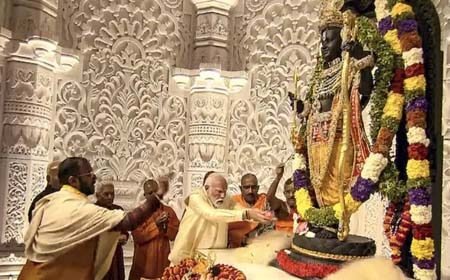Today, December 12 is the Day of Delhi Hindu Killing by Taimur Long. On this day in 1338, Timur’s forces massacred millions of Hindus, wreaked havoc and looted Delhi. Delhi was reduced to rubble. Timur Long looted many valuable resources. Such was the massacre and so many people were killed that no bird flew in the skies of Delhi for two months after the massacre. It took Delhi almost a hundred years to overcome that shock. According to historians, Timur killed a total of 17 million people which is 5-7% of the total population of the world at that time. There is no other example of such cruelty. Delhi Hindu Massacre Day
It was during the Tughlaq period that Timur Long Jhtika of Samarkand invaded Delhi and defeated Sultan Nasiruddin Mahmud, the last surviving member of the Tughlaq dynasty. Sultan Nasiruddin fled to Gujarat.
Taimur wrote in his autobiography – I stayed in Delhi for 15 days. The days were spent quite happily and happily. I have held a court I have given a big feast. Then I remembered that I came to Hindustan to fight against the infidels. By God’s grace I have had unexpected success everywhere. I killed millions of infidel Hindus. The holy sword of Islam has been washed to listen to them, so now is not the time for rest, but continuous war should be waged against the infidels.
This murder was so diabolical that the Muslim officials in various places spread the news and ordered the Hindus to convert to Islam; If the order is not followed, Timur’s army will be informed, this threat is also shown. As a result, fearful people in different places started becoming Muslims in groups. That is why the word “Shune Musalman” is still prevalent in Bengal.India invaded Timur Long. He attacked Delhi on the pretext that the Sultans of Delhi were showing kindness to the pagans instead of eradicating paganism. On the way to Delhi, they looted places like Dipalpur, Bhatnei and destroyed the lives of countless men and women and came to the outskirts of Delhi. There he killed about one lakh Hindu prisoners and committed a hellish act. Then when Timur reached Delhi, fed up with the brutality of his army, Hindu citizens tried to defend themselves and a massive massacre started. Timur’s wretched army stained the city of Delhi with the blood of countless Hindu men and women. After days of demonic killings and looting in the city of Delhi, Timur entered three other cities including Siri, Jahapna and Old Delhi and committed similar looting and killings.
David Price in his book ‘Memoirs of the Principal Events of Mahamedan History’ writes, “No other instance of this cruelty is to be found in human history.”
In his autobiography Mulfijat Timuri, he wrote, “My greatest concern was the mighty Indian elephants. I heard many stories about that elephant group in Samarkand. But I saw how strong they are in the first fight. On the backs of those elephants there were big huts, and there were soldiers throwing torches, archers sitting with the mahout. It was also heard that the tusks of the elephants were poisoned, and the elephants used to insert the poisoned tusks directly into the stomach of the soldiers. Elephants could not be injured by arrows or bows.”
Timur was planning how to deal with the Indian elephants. He ordered the soldiers to aim their arrows at the elephant mahouts.Sikandar Shah was a very pious Muslim. He used to torture Hindus unspeakably. It was on his orders that the famous Hindu temple of Mathura was razed to the ground. He banned Hindus from bathing in the river Yamuna. Jainaka Brahmon lost his favor on the order of the Sultan for the crime of saying “Hinduism is in no way inferior to Islam”. He was a fierce Hindu hater and a very pious Muslim ruler according to Islam. The Hindus of Kashmir were forced to convert to Islam under his tyranny and orders.
(Source: Bharat History, Dr. KC Chowdhury, p-137)
Then…Kashmir Hindus used to wrap their heads to protect the girls. It is known that when Timur Long’s 90,000 soldiers gathered in Samarkand to march towards Delhi, the entire city was covered in dust. Delhi is about a thousand miles away.
The road to reach Delhi was the most difficult road in the world at that time. The Hindu Kush mountains had to be crossed on that way. And those who lived on the side of the road, even Alexander the great could not defeat them. In between there were many rivers, rocky roads and deserts, which made the road to Delhi even more impassable. If Timur’s army had been able to cross that road, then they would have had to face a huge army of elephants.
Timur’s army did not know how to deal with them. But the soldiers had heard many stories about those elephants. The herd of elephants would not only uproot houses or trees, but if any wall fell in front of them, they would easily break it and make their way. Their trunks were so strong that they could twist any soldier and crush them under their feet.
As Timur advances towards Delhi, the situation in Delhi is in turmoil. After the death of Firoz Shah Tughluq in 1338, the whole of India was divided into three parts – Bengal, Kashmir and Deccan.
Renowned historian Sir George Dunbar writes in his book ‘The History of India’, “Within two years of Feroze’s death, Delhi was ruled by five kings, his grandsons and his younger son. The condition of Delhi was such that it was inviting a foreign invader to attack.”
The hill climb started outside Samarkand. Timur’s biggest challenge was somehow getting 90,000 soldiers, twice as many horses, across the roof of the world. The Tibetan Plateau in Central Asia is called the roof of the world.
Justin Marozzi, in his book Tamerlane, Sword of Islam, Conqueror of the World, writes, “Timur’s army was crossing regions with different climates. Had someone else led the army instead of Timur, the weather alone would have been enough to finish him off.”
His book mentions, “The entire logistics of Timur’s army was carried on the backs of about one and a half lakh horses. Six hundred years after that expedition, one still frets about the poor weather conditions when passing through the area’s snow-covered passes.”
By August they had reached Kabul. And within two months they reached the banks of river Shatadru. Sarang Khan blocked their way there. Taimur did not have to gain much speed to win that fight. Timur captured about one lakh Hindus on their way to Delhi from there. Reaching very close to Delhi, Timur set up his camp at Loni.
Timur Long used to keep an eye on the situation in Delhi from a hill on the banks of the river Yamuna. Although at that time preoccupied with turmoil among themselves, Delhi’s power did not diminish much. Ten thousand cavalry, 25 to 40 thousand foot soldiers and 120 elephants were still ready to face Timur Lang within the walls of the fort.
Justin Marozzi writes, “The first battle between the two sides broke out when Mallu Khan’s forces attacked an advance party of Timur’s seven hundred soldiers. Muhammad Shah was ruling Delhi at that time, but Mallu Khan was running the administration.” One of Timur’s fears was that if Mallu Khan’s soldiers attacked him, the nearly 100,000 Hindu prisoners accompanying him would side with the Delhi troops.
“So great was Timur’s apprehension of those prisoners who were trailing behind his army that he ordered them to be killed one by one there. Even the Maulanas accompanying him were ordered to kill the prisoners with their own hands,” writes Justin Marozzi.
David Price in his book ‘Memoirs of the Principal Events of Mahamedan History’ writes, “No second instance of this cruelty is to be found in human history.”
In his autobiography Multinat Timari, he wrote, “My greatest concern was the mighty Indian elephants. I heard many stories about that elephant group in Samarkand. But I saw how strong they are in the first fight. On the backs of those elephants there were big huts, and there were soldiers throwing torches, archers sitting with the mahout. It was also heard that the tusks of the elephants were poisoned, and the elephants used to insert the poisoned tusks directly into the stomach of the soldiers. Elephants could not be injured by arrows or bows.”
Timur was planning how to deal with the Indian elephants. He ordered the soldiers to aim their arrows at the elephant mahouts.
December 17, 1398. Mallu Khan and Sultan Mahmud’s army marched out of Delhi Darwaza to fight Timur. They kept the elephant group in the middle. Soldiers were sitting on their backs with weapons. Everything was observed by Timur standing on a high hill.
Timur himself faced the thick mustached Indian sepoys and shortly before the battle began, Timur prostrated and prayed for victory. At the end of the battle, Timur’s archers started attacking Malla Khan’s army from the right. In response, Mallu Khan ordered Timur’s forces on the left to attack from the right.
At one point, Timur saw a clamor rising among his army for Indian elephants. He had already prepared for this. Some camels were prepared, with dry wood and grass tied on their backs. He ordered the camels to advance and told the army to set fire to dry grass and wood.
Justin Marozzi writes, “Suddenly the camels came before the elephants with burning wood and grass on their backs. The elephants got scared and started attacking their own soldiers on the opposite side. Mallu Khan’s forces then hurried to escape.” Historian Khan Damir also mentioned this incident in his book ‘Habib us Siyar’.
“Suddenly it appeared like a coconut falling from a tree. The battlefield was littered with severed heads of Indian soldiers.”
“Pir Muhammad, Timur’s commander from the right, chased the Indian army past the walls of Delhi and then succumbed. Meanwhile, an elephant and the Indian soldiers on its back were seized and Timur’s 15-year-old grandson Khalil was brought before his grandfather.”
In his autobiography, Timur wrote, “I was moving forward with a sword in one hand and a knife in the other. Both hands were moving together. I cut two elephant trunks. The two elephant trunks that I had cut were bent to one side with bent knees. The soldiers sitting on their backs fell to the ground. Then Hindustani sepoys with big mustaches tried to block my way.”
“I was moving both arms so fast that I was amazed at my own strength. Sepoys with thick mustaches were falling one by one in front of me and I was slowly moving towards the city gates,” wrote Taimur Long. At this time, he again sat on the horse’s back but suddenly the horse’s reins came loose from his hands.
Timur writes in his autobiography, “I looked at my hand in the light of the torch to understand how the bridle of the horse became loose. I understood the reason. My hand was full of blood, and the bridle ran because of it. Then look at the rest of the body. I felt as if I had been drenched in a pool of blood. I got five injuries on my wrist and two legs.”
By then Timur’s forces had entered Delhi. The next day Timur Long entered Delhi like a conqueror. A tent was erected and Timur’s court was seated there. Sultan Mahmud’s court and noble people of Delhi were presented in that court. From this it can be understood that Timur Long has completely taken control of Delhi. Sultan Mahmud and Mallu Khan of Delhi fled the battlefield.
In the words of Justin Marozzi, “One by one 100 elephants, which were still alive, were presented before Timur. Those elephants saluted Timur sitting with folded knees. Timur decided to send the elephants as gifts to the princesses of Tabriz, Shiraz, Arzinjan and Shirwan. He will also send ambassadors to those states, so that the news will spread throughout Asia that Delhi is now in the possession of Timur Long.”
After the battle Timur turned his attention to his attack on Delhi. He began to calculate the extent of Delhi’s treasury, and wondered what booty he would take from Delhi. His soldiers were going from house to house telling the people how much money each had to pay to Timur.
According to Sharafuddin Ali Yazdi, there were at least 15,000 troops of Timur within the boundaries of Delhi at that time. Some soldiers were busy looting Anajpati. The princes and nobles of Delhi were brought before Timur.
Muhammad Kashim Ferishta in his book ‘History of the Rise of Mohammedan Power in India’ writes, “When the Hindus saw their women being insulted and their wealth looted, they closed the doors of their houses and set them on fire. They killed their wives and children and jumped on Timur’s army. It was during this period that Delhi witnessed the massacre. All the streets are dead bodies. The rest of Timur’s army also entered Delhi. The residents of Delhi were forced to surrender within days.” Mughal forces drove the inhabitants of Delhi towards Old Delhi. Residents took refuge in a mosque there.
In the words of Justin Marozzi, “An army of 500 Timur soldiers attacked the mosque. They killed the people who took refuge there one by one. The soldiers cut off the heads of the dead and made a minaret and left the rest of the bodies for the crows to eat. This massacre went on for three days.”
Ghiyas uddin Ali in his book ‘Diary of Timur’s Campaign in India’ wrote, “Timur’s army attacked Delhiites like a flock of sheep let loose before a hungry wolf. As a result, Delhi, famous for its wealth, jewelry, diamond jewelry and perfumes, turned into a burning inferno. The smell of rotting dead bodies was coming from all around.”
On the other hand, Timur Long was relaxing in his tent. No news of the carnage going on in Delhi reached him. His generals did not dare to convey this news to Timur. But some historians have doubts as to why no news reached Timur. This is because Timur’s army was famous for strict discipline. They could not have looted or massacred like this if the order did not come from above.
Although there was a difference of opinion as to whether or not the orders for looting had come, their eyes were bound to rise to their foreheads at the sight of the prosperity of Delhi. Scattered around were gold, silver, jewels, pearls, precious stones, expensive cloths. But more than all these, their attraction was on the common people of Delhi. They could be made to do whatever they wanted. When Timur’s army started to retreat, every soldier was accompanied by 150 common Delhiites.
Taimur was in Delhi for only two weeks. Meanwhile, he forced the Shahzadas of Delhi to surrender. Nazrana also collects. He took the initiative to tie the hands of several artisans and take them to Samarkand. Timur’s army had plundered so much property that they could move very slowly under its weight. Again, on the way back, Timur’s army participated in about 20 battles, small and big, and looted from there too.























